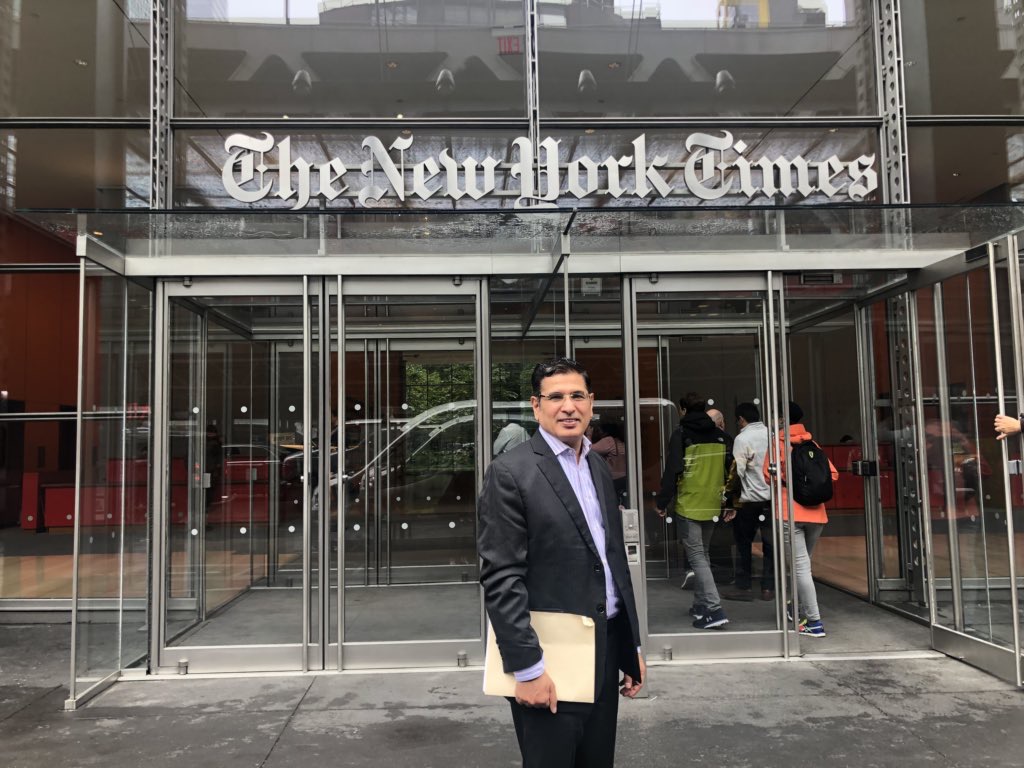
Sayidaty and AboutHer Editor-in-Chief, Mohammed Fahad Al-Harthi started his US media tour on September 11, visiting major American media organizations in order to follow up on trends and developments in global technology.
His visit covered big names like The New York Times, Reuters, Associated Press, Wall Street Journal, and more. During the meetings and presentations, he learned about the innovations, strategies, and experiences of these establishments in increasing revenues and sources of income.
Al-Harthi highlighted his journey on his personal twitter, and perhaps one of the most interesting observations of his, was that of the Artificial Intelligent employees.
He talks about the notion in a tweet:
هل تتخيل أن 3700 قصة صحفية توزعها وكالة أسوشيتدبرس لا يشارك فيها إنسان. بل هي تكتب وتراجع يالروبوت (الصحفي الآلي). وتعتمد هذه على AI الذكاء الاصطناعي. ووضعت جيبس مديرة التكنولوجيا، قصتين صحفية، واحدة لروبرت والثانية لصحفي بشري. ولَم نستطع أن نميز الفرق.#زيارة_الصحف_الأمريكية pic.twitter.com/vyuRQPMfpB
— محمد فهد الحارثي (@mfalharthi) 17 septembre 2018
“Can you imagine that 3700 journalism articles being posted by Associated Press are not by humans? They are written and reviewed by robots (auto reporters), which rely on Artificial Intelligence. Gibbs, the technology director, showed us 2 stories, one by a robot and one by a human reporter, and we couldn’t tell the difference.”
He continues on to state that the stories written by the robots are direct stories, such as corporate quarterly results.
القصص للصحفية التي يكتبها الروبوت هي القصص المباشرة مثل النتائج الفصلية للشركات أو نتائج المباريات. ويقول جيم كيندي مدير الاستراتيجيات في الأسوشيتدبرس AP أن هذا ساعدهم في مضاعفة عدد القصص الصحفية المباشرة، وتفريغ الصحفيين (البشر) للمواضيع المهمة. #زيارة_الصحف_الأمريكية pic.twitter.com/Zdaiz9BBfA
— محمد فهد الحارثي (@mfalharthi) 17 septembre 2018
“This has helped us to double the number of direct stories, and to have journalists (humans) write the important topics,” said Jim Kennedy, director of strategy at The Associated Press, as reported by Al-Harthi.
Another highlight of the trip, was the fact that some media organizations are following the incubator business model in an attempt to foster talent and growth.
من الأفكار الخلاقة لوول ستريت جورنال إنها تشجع موظفيها على بدء أعمالهم الخاصة بجانب عملهم, وتساندهم بعمل حاضنات اعمال incubate startups في المشاريع المرتبطة بتكنولوجيا الاعلام.وهي بذلك تكسب ولاء الموظفين وفي نفس الوقت تستفيد الصحيفة من هذه المشاريع.#زيارة_الصحف_الأمريكية pic.twitter.com/zYtHuBFA1l
— محمد فهد الحارثي (@mfalharthi) 14 septembre 2018
“One of Wall Street Journal’s innovative ideas is that they encourage their employees to start their own businesses alongside their work,” explained Al-Harthi in a tweet, “They serve as incubators for start-up projects in the technology information field. They would be gaining the loyalty of their employees, while also benefiting from the projects.”
In other news, the Editor-in-Chief met with other fellow Saudis on his trip:
نفتخر بالشباب السعودي في كل مكان. وكم كانت سعادتي حينما وصلت مؤتمر ONA في أوستين (أكبر مؤتمر عالمي في الديجتال) لأجد شاب سعودي ينهي إجراءات تسجيلي. وهو المبتعث محمد القرني يدرس الماجستير في الاعلام الرقمي بجامعة ولاية ميزوري.انتدبته الجامعة للحضور لتميزه.#زيارة_الصحف_الأمريكية pic.twitter.com/v62xGdGuo0
— محمد فهد الحارثي (@mfalharthi) 18 septembre 2018
“We are so proud of Saudi youth everywhere,” he tweeted out. “When I arrived to the ONA Conference in Austin, I was glad to have met this young Saudi. Mohammed al-Qarni is a Master’s student in Digital Media at the University of Missouri.”

















